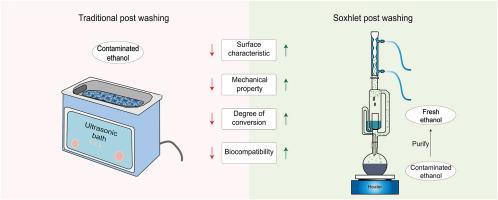使用索氏装置洗后可改善3D打印树脂在污染溶剂中的力学性能和生物相容性
IF 3.5
2区 医学
Q2 ENGINEERING, BIOMEDICAL
Journal of the Mechanical Behavior of Biomedical Materials
Pub Date : 2025-08-28
DOI:10.1016/j.jmbbm.2025.107176
引用次数: 0
摘要
基于光聚合的3D打印因其精度和可定制性而广泛应用于牙科制造。然而,打印的树脂标本需要有效的后冲洗以去除未聚合的树脂,这是影响其机械性能和生物相容性的关键步骤。由于残余树脂污染溶剂,传统的超声波浴可能无法实现有效的后洗,导致清洗不完全和可能的再沉积。本研究探讨了使用索氏装置作为一种创新的后洗方法。通过不断刷新溶剂,索氏后洗确保有效去除残留树脂。结果表明,索氏洗后将污染溶剂的浊度恢复到新鲜乙醇的浊度,表明表面污染显著减少。力学试验表明,用索氏装置处理的试样的维氏硬度和抗拉强度明显高于用污染的超声波浴处理的试样。傅里叶变换红外光谱、拉曼光谱和照片- dsc分析表明,污染的索氏仪组的转化程度高于污染的超声浴组。细胞活力测定证实,细胞毒性渗滤液在索氏水洗后减少,导致更高的生物相容性。这些发现表明,索氏洗后技术克服了溶剂污染的限制,为提高3D打印树脂的质量和临床性能提供了一种有前途的方法。本文章由计算机程序翻译,如有差异,请以英文原文为准。

Post-washing using a Soxhlet apparatus improves the mechanical properties and biocompatibility of 3D printing resin in contaminated solvent
Photopolymerization-based 3D printing is widely used in dental manufacturing due to its precision and customizability. However, printed resin specimens require effective post-washing to remove unpolymerized resin, which is a critical step that affects both their mechanical properties and biocompatibility. A conventional ultrasonic bath may fail to achieve effective post-washing due to solvent contamination by the residual resin, resulting in incomplete cleaning and possible redeposition. This study investigated the use of a Soxhlet apparatus as an innovative post-washing method. By continuously refreshing the solvent, Soxhlet post-washing ensures the effective removal of residual resin. The results showed that Soxhlet post-washing restored the turbidity of the contaminated solvent to that of fresh ethanol, indicating a significant reduction in surface contamination. Mechanical tests showed that the Vickers hardness and tensile strength were significantly higher for specimens treated by a Soxhlet apparatus than when using a contaminated ultrasonic bath. Fourier-transform infrared spectroscopy, Raman spectroscopy and photo-DSC showed that the degree of conversion was higher in the contaminated Soxhlet apparatus group than in the contaminated ultrasonic bath group. Cell viability assays confirmed that cytotoxic leachates were reduced after Soxhlet post-washing, resulting in higher biocompatibility. These findings suggest that Soxhlet-based post-washing overcomes the limitations of solvent contamination and provides a promising approach to improve the quality and clinical performance of 3D printing resin.
求助全文
通过发布文献求助,成功后即可免费获取论文全文。
去求助
来源期刊

Journal of the Mechanical Behavior of Biomedical Materials
工程技术-材料科学:生物材料
CiteScore
7.20
自引率
7.70%
发文量
505
审稿时长
46 days
期刊介绍:
The Journal of the Mechanical Behavior of Biomedical Materials is concerned with the mechanical deformation, damage and failure under applied forces, of biological material (at the tissue, cellular and molecular levels) and of biomaterials, i.e. those materials which are designed to mimic or replace biological materials.
The primary focus of the journal is the synthesis of materials science, biology, and medical and dental science. Reports of fundamental scientific investigations are welcome, as are articles concerned with the practical application of materials in medical devices. Both experimental and theoretical work is of interest; theoretical papers will normally include comparison of predictions with experimental data, though we recognize that this may not always be appropriate. The journal also publishes technical notes concerned with emerging experimental or theoretical techniques, letters to the editor and, by invitation, review articles and papers describing existing techniques for the benefit of an interdisciplinary readership.
 求助内容:
求助内容: 应助结果提醒方式:
应助结果提醒方式:


